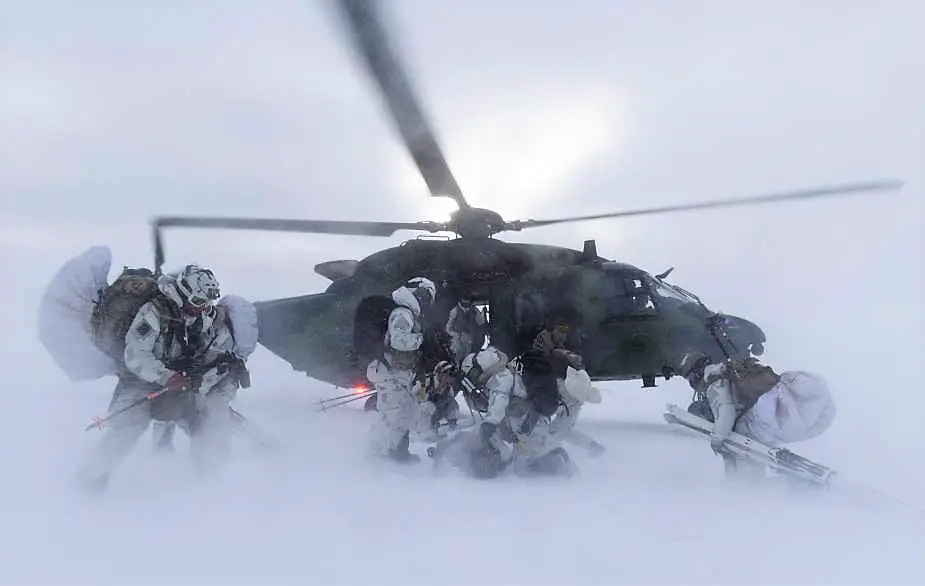Analysis: Arctic heating up literally and as scene of strategic competition
The Arctic is heating up, both literally and figuratively, and the United States and its allies are working together to address both aspects of this. Climate change is literally warming the Arctic; figuratively, the region is becoming a theater of great power competition. Jim Garamone, U.S. Department of Defense, elaborates.
Follow Army Recognition on Google News at this link
t
US Special Forces load onto a Finnish helicopter in Lapland, Finland, on March 12, 2023. In the Arctic, Temperatures regularly go to -40 degrees Fahrenheit, which changes the way engines operate, the viscosity of oil, the amount of time a soldier can be exposed to the weather and much more (Picture source: U.S. DoD)
"There's been so much change happening in the last 10 to 20 years with climate change driving increased activity, geopolitical change, also technological change," said Iris Ferguson, deputy assistant secretary of defense for Arctic strategy and global resilience. Ferguson spoke of the strategy in the Far North during a panel discussion at the Sea-Air-Space conference on Monday. Also on the panel were: Coast Guard Vice Commandant Adm. Steven D. Poulin; Vice Adm. Angus Topshee, commander of the Royal Canadian Navy; and U.S. Navy Vice Adm. William Houston, commander of Naval Submarine Forces.
The warming climate has opened trade passages formerly ice-choked. It opens areas to exploration, industry and, perhaps, settlement. The warming climate opens the region to the exploitation of its natural gas and oil fields and rare-earth deposits. The warming trend also is "allowing our adversaries to have greater presence and access to the region," Ferguson said. "There's a sense that we in the Pentagon also need to be thinking more proactively about what we need to operate in the theater, how we work closely with our allies and partners."
Since the beginning of the Cold War, the Arctic has been an avenue of approach to the homeland. Soviet bombers and missiles would fly over the Arctic to strike America. The United States and Canada established the North American Aerospace Defense Command and built radars and bases throughout the Far North to defend against such an onslaught. The Arctic remains a strategic approach to the homeland. Even today, much of the U.S. missile defense infrastructure is there.
Russia has staked out large claims in the Arctic, and even China has declared itself to be "a near-Arctic state" in an effort to be relevant in the region. The United States and its allies must ensure they have the right capabilities in the region to detect threats and operate.
With the fall of the Soviet Union, there was the idea that the Arctic was stable, Ferguson said. "The sense that the Arctic is stable is changing, it's becoming increasingly unstable," she said. "So now, how do we collectively work together to ensure deterrence and how we work together to ensure stability long term?."
The U.S. military services and the combatant commands are working on the Arctic strategy. Ferguson's office is working with them and with allies and partners to craft a strategy to ensure a safe and secure region that remains peaceful. It is complicated. Officials have to have the right domain awareness to detect threats; they have to understand the changing environment to figure out what capabilities will be needed, she said. Troops need to exercise in the region and develop new tactics and equipment to operate there. Ferguson is working on a new Defense Department Arctic strategy based on President Joe Biden's Arctic strategy released last year.
With all the talk of warming in the Arctic, it is still not warm. Temperatures regularly go to -40 degrees Fahrenheit, which changes the way engines operate, the viscosity of oil, the amount of time a soldier can be exposed to the weather and much, much more. Ferguson noted that the climate is different in different parts of the region with Finland's Arctic being cold and wet, while Alaska's is cold and dry.
A little farther north, communications in what's known as the High North are spotty, and infrastructure is sparse. Units operating in the region must bring all supplies with them. "The strategic gets tactical really quick. It's a matter of life and death," Ferguson said. "You can't go and talk about strategies without talking about some of the real tactical requirements of operating there. I think that's one of the most telling things I find about working on this issue."
Defense News April 2023


























